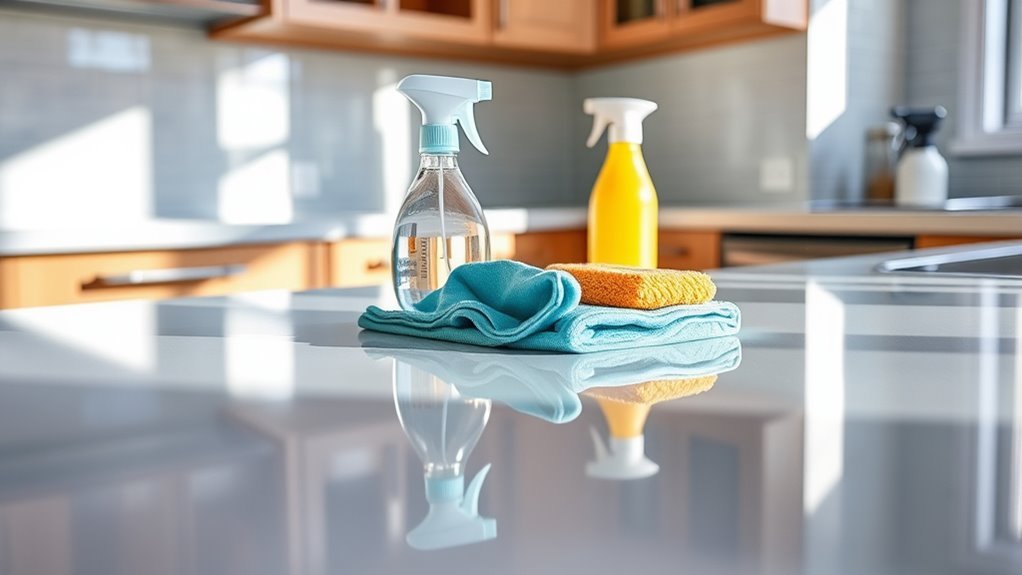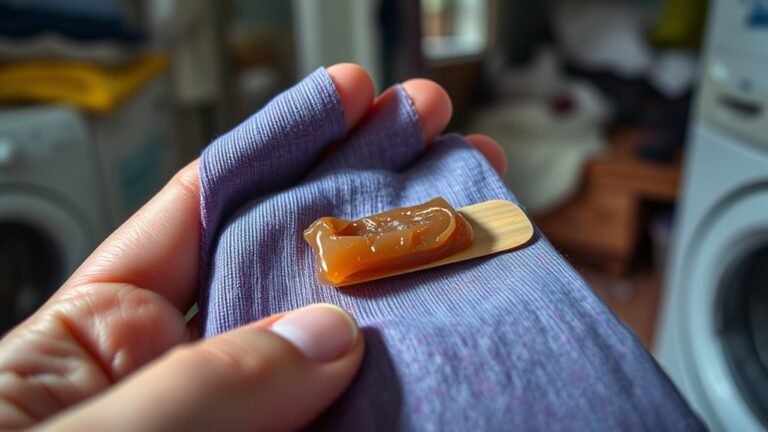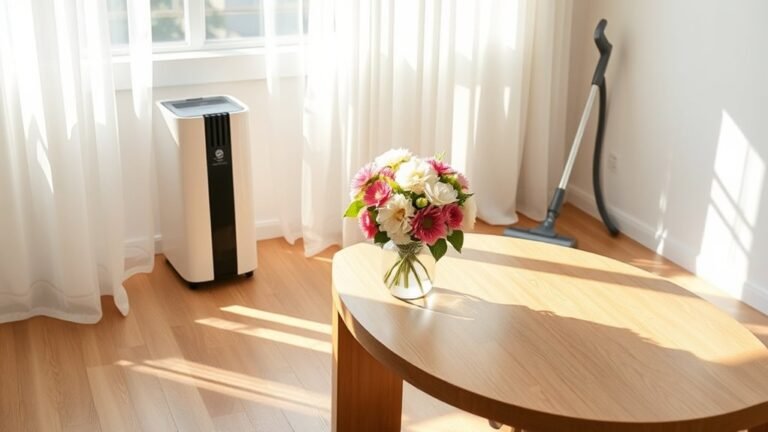Top 10 Tips for Cleaning Laminate
To clean laminate floors effectively, choose gentle cleaners like mild detergent with water, avoiding bleach or wax products. Use a microfiber mop to dust regularly, and never soak floors—wring mops well to prevent water damage. Clean spills immediately with a soft cloth, and vacuum with a soft brush to avoid scratches. Maintain home humidity around 35-55%, and protect furniture legs with pads. These essential steps help keep your floors looking great and durable; more tips can help enhance their care.
Choose the Right Cleaning Products

When choosing cleaning products for laminate, you’ll want to avoid anything abrasive or overly harsh, as these can damage the surface. Opt for cleaning solutions specifically designed for laminate floors or gentle all-purpose cleaners diluted with water. Avoid bleach, ammonia, or wax-based products since they can dull or warp the finish. You’ll find that a mild detergent mixed with warm water often offers the best balance of product effectiveness and surface safety. Test any new cleaner in a small, inconspicuous area first to verify it doesn’t leave residue or discoloration. Staying consistent with the right cleaning solutions lets you maintain your laminate’s appearance and durability without restricting your freedom to clean efficiently and confidently.
Use a Microfiber Mop for Dusting
Since dust and dirt can quickly accumulate on laminate surfaces, using a microfiber mop is one of the most effective ways to keep them clean without causing damage. The microfiber benefits include its ability to trap dust and debris efficiently without scratching your floors. When dusting, use gentle, overlapping strokes to cover every inch without stirring up particles into the air. This method also reduces the need for harsh chemicals, giving you more freedom to maintain a natural clean. Remember to regularly rinse or replace the microfiber pad to guarantee peak performance and prevent dirt buildup. By mastering these dusting techniques, you’ll extend the life of your laminate flooring while keeping your space fresh and free of allergens.
Avoid Excess Water on Laminate Floors

Although laminate floors are durable, they aren’t designed to handle excess water, which can cause warping or swelling. To protect your floor’s laminate longevity, always use a damp—not soaking—mop or cloth when cleaning. Avoid pouring water directly onto the floor; instead, wring your mop thoroughly to prevent water pooling. Standing water invites water damage, which can ruin the integrity of your flooring and lead to costly repairs. Keep a spray bottle handy for applying cleaning solutions sparingly, ensuring you don’t oversaturate the surface. By controlling moisture levels during cleaning, you maintain your laminate’s appearance and strength. This simple habit gives you the freedom to enjoy your floors without worrying about damage from excess water.
Clean Spills Immediately
When spills happen, you’ll want to clean them up right away to prevent stains from setting. Grab a soft cloth to gently blot the area without spreading the liquid. Acting quickly keeps your laminate floor looking fresh and damage-free.
Prevent Stains Quickly
Because laminate is prone to staining, you should clean spills immediately to prevent permanent marks. A quick response is key to effective stain prevention. As soon as you notice a spill, grab a clean, absorbent cloth or paper towel to blot the liquid—avoid rubbing, which can spread the stain. For sticky or colored substances like juice or coffee, wiping quickly stops them from settling into the surface. Keep a small cleaning kit nearby to make your response effortless. The faster you act, the less chance stains have to form, preserving your laminate’s appearance and extending its lifespan. Staying vigilant and responding promptly gives you freedom from tough stains and costly repairs, keeping your laminate looking fresh and clean every day.
Use Soft Cloth
A soft cloth is essential for cleaning spills on laminate surfaces quickly and effectively. When a spill happens, grab a soft cloth immediately to prevent liquids from seeping into seams or causing stains. The soft cloth benefits include its gentle touch, which protects the laminate’s finish from scratches and dulling. Using harsh materials can damage the surface, so stick to soft cloths for all cleaning techniques. Dampen the cloth slightly with water or a mild cleaner, then blot the spill—avoid rubbing, which can spread the mess. This simple habit keeps your laminate looking fresh and prolongs its life, giving you freedom from constant worry about stains or damage. Being precise and prompt with a soft cloth is your best defense.
Remove Stubborn Stains Gently

Although stubborn stains can be frustrating, you don’t have to resort to harsh chemicals that might damage your laminate. Use effective stain removal techniques combined with gentle scrubbers like microfiber cloths or soft sponges. Test any cleaner on a small area first to avoid discoloration.
| Stain Type | Recommended Method |
|---|---|
| Coffee/Tea | Mild detergent + sponge |
| Ink | Rubbing alcohol + cloth |
| Grease | Dish soap + soft brush |
| Crayon/Marker | Baking soda paste + cloth |
| Water Marks | Vinegar solution + cloth |
Apply treatments gently and avoid scrubbing aggressively. This helps maintain your laminate’s finish while removing stains efficiently.
Protect Floors From Furniture Scratches
To keep your laminate floors scratch-free, start by attaching furniture pads to chair and table legs. Never drag heavy items across the floor; always lift them to avoid damage. Also, regularly rearranging your furniture helps prevent constant wear in one spot.
Use Furniture Pads
When you want to keep your laminate floors looking new, using furniture pads is essential. These small protectors prevent scratches and dents caused by chair legs, tables, and other furniture. There are various furniture pad types, including felt, rubber, and cork. Felt pads are soft and ideal for lightweight furniture, while rubber pads provide more grip and suit heavier pieces. Cork pads offer a balance of protection and durability. Choosing the right furniture pad materials depends on your furniture’s weight and how often you move it. Make sure to check and replace pads regularly, as worn pads lose effectiveness and can trap dirt, which may scratch the floor. By selecting appropriate pads and maintaining them, you’ll preserve your laminate floors, giving you the freedom to rearrange without worry.
Avoid Dragging Furniture
Dragging furniture across laminate floors can cause deep scratches and permanent damage. To protect your floors, always lift furniture when moving it instead of sliding. Plan your furniture placement carefully to minimize the need for frequent moves. When rearranging isn’t an option, placing protective floor pads or rugs beneath heavy pieces offers an effective barrier against scratches. These simple steps guarantee your laminate maintains its sleek appearance, giving you freedom to enjoy your space without worrying about costly repairs. Prioritize floor protection by combining smart furniture placement with consistent lifting habits. This approach not only preserves your laminate’s finish but also keeps your room looking fresh and inviting. Avoid dragging — it’s the key to long-lasting laminate beauty and hassle-free maintenance.
Regularly Rearrange Items
Although laminate floors are durable, regularly rearranging your furniture and decor helps prevent uneven wear and scratches in high-traffic areas. To protect your floors and maintain a fresh look, follow these steps:
- Organize items systematically: Shift furniture and decor to new spots to distribute foot traffic evenly and avoid constant pressure on one area.
- Declutter space before moving: Clear smaller items to prevent accidental drops or scratches when rearranging.
- Use protective pads: Place felt pads under furniture legs before moving to safeguard against dragging damage.
Regularly Vacuum With a Soft Brush Attachment
Regularly vacuuming your laminate floors with a soft brush attachment helps prevent scratches and removes dirt trapped in grooves. To protect your floors, use gentle vacuuming techniques: move the vacuum slowly and avoid pressing down hard. This guarantees you lift debris without damaging the surface. Pay attention to brush maintenance by cleaning the attachment regularly—remove hair and dust buildup to maintain its softness and effectiveness. Replace the brush if bristles become stiff or worn; a worn brush can cause scratches. By sticking to these simple habits, you keep dirt from embedding and preserve your laminate’s finish. This approach not only extends your floor’s life but also gives you the freedom to enjoy a clean, scratch-free space without extra hassle.
Use Vinegar and Water for Natural Cleaning
One simple and effective way to clean your laminate floors is by using a mixture of vinegar and water. This vinegar solution acts as a natural disinfectant, cutting through grime without harsh chemicals. Here’s how to get it right:
- Mix 1 cup of white vinegar with 1 gallon of warm water.
- Lightly dampen a microfiber mop or cloth in the solution—avoid soaking the floor.
- Mop your laminate gently, ensuring quick drying to prevent warping.
This natural method frees you from relying on chemical cleaners while maintaining your floor’s shine. Remember, the vinegar solution is safe, effective, and budget-friendly, making it an ideal choice for regular cleaning. With this approach, you control what touches your floors, embracing a cleaner, greener lifestyle.
Avoid Abrasive Cleaners and Tools
Because laminate floors can scratch easily, you should steer clear of abrasive cleaners and tools that might damage the surface. Avoid harsh scrub brushes, steel wool, or scouring pads—these abrasive materials can leave permanent marks. Instead, opt for soft microfiber cloths or mops designed for delicate flooring. When choosing cleaning techniques, stick to gentle solutions like diluted vinegar or mild soap to keep your floors spotless without risking harm. Always test new cleaners on a small, inconspicuous area first to verify they won’t dull or scratch the laminate finish. By avoiding abrasive materials and using careful cleaning techniques, you’ll maintain the floor’s smooth appearance and extend its lifespan, giving you the freedom to enjoy a beautiful, worry-free home environment.
Maintain Proper Humidity Levels in Your Home
Although laminate floors are durable, they can warp or gap if humidity levels aren’t properly controlled. To keep your floors looking great and maintain their integrity, focus on effective humidity control and air circulation. Here’s what you can do:
- Use a humidifier or dehumidifier to keep indoor humidity between 35-55%, preventing excessive moisture or dryness.
- Open windows and use fans regularly to promote air circulation, especially in rooms prone to moisture buildup.
- Avoid placing water sources near laminate flooring and promptly wipe up spills to minimize humidity spikes.
Häufig gestellte Fragen
Can Laminate Flooring Be Installed in Bathrooms or Basements?
Think of laminate flooring like a shield—it’s got some laminate moisture resistance, but it’s not invincible. You can install it in bathrooms or basements, but you’ve got to be careful. For bathroom installation tips, make sure to use waterproof underlayment and seal all edges to keep water out. In basements, control humidity and use a moisture barrier. This way, you’ll protect your floors while enjoying the freedom of stylish, durable laminate.
How Often Should I Refinish or Reseal Laminate Floors?
You don’t usually need to worry about refinishing frequency with laminate floors since they’re designed to resist wear without refinishing. Instead, focus on resealing tips to keep moisture out—apply a sealant around edges every few years if you notice gaps or water damage. Regular cleaning and avoiding standing water help extend their life, giving you more freedom to enjoy your space without constant maintenance hassles.
Are There Specific Brands of Laminate That Are More Durable?
Did you know some laminate floors can last over 20 years with proper care? When you’re exploring durable brands, focus on those with high AC ratings—like AC4 or AC5—for better wear resistance. Brands like Pergo and Armstrong often top laminate comparisons for durability and style variety. Choosing wisely means you get freedom from frequent replacements, letting you enjoy your space without worrying about constant upkeep or damage.
Can I Use Steam Cleaners on Laminate Flooring?
You might be tempted to use a steam cleaner on your laminate flooring because of steam cleaner benefits like deep cleaning without chemicals. However, you should avoid it since the moisture and heat can damage laminate care by warping or peeling the surface. Instead, stick to damp mops and gentle cleaners to keep your floors looking great while maintaining their finish and durability. This way, you get freedom from damage and long-lasting beauty.
What Temperature Range Is Best for Laminate Floor Stability?
You don’t want your laminate flooring to feel like it’s living in a sauna or an igloo—that’s how temperature effects can wreak havoc. For the best stability, keep your room temperature between 60°F and 80°F. Humidity levels should stay around 30% to 50% to prevent warping or swelling. Controlling these factors lets you enjoy beautiful, durable floors without feeling trapped by extreme climate conditions.






